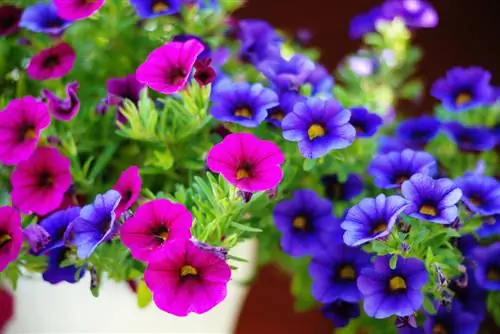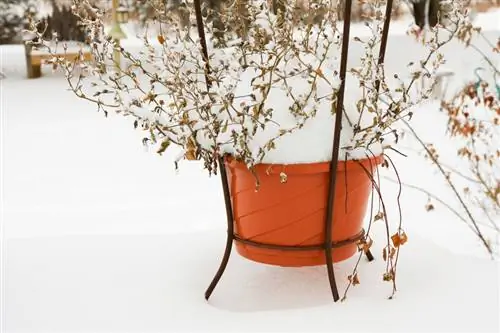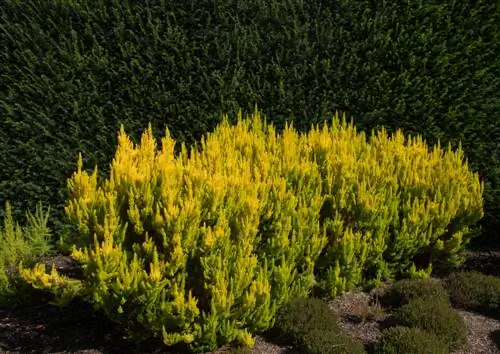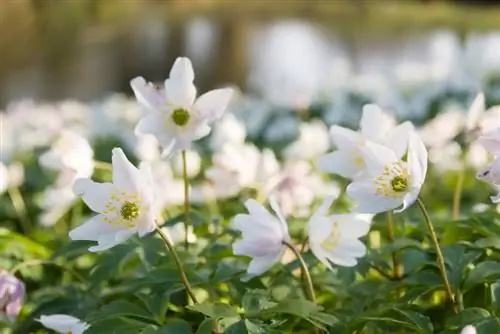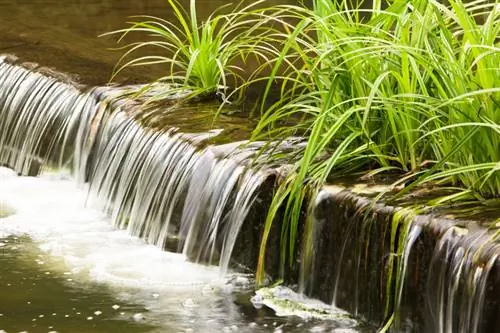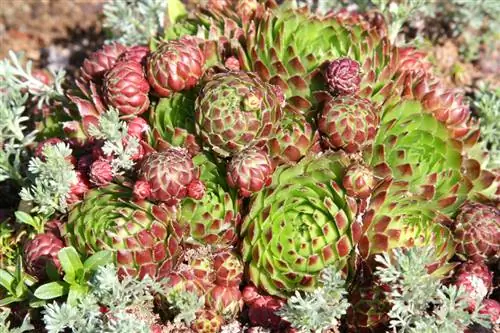- Author admin [email protected].
- Public 2023-12-25 17:45.
- Last modified 2025-01-23 11:19.
Petunias are available in many colorful variations, which makes the easy-care summer flower a popular plant for balconies and gardens. The lush flowers can be admired throughout the entire growing season between spring and well into autumn. So that you can enjoy them undisturbed, we have put together the most important facts about planting and caring for petunias for you.
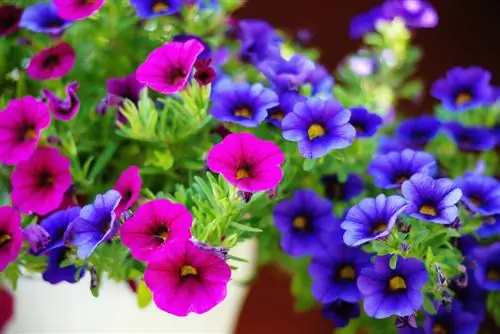
Origin and distribution
The garden petunia that is so popular with us is not, strictly speaking, a separate species, but one that dates back to the 19th century. Hybrid bred in the 19th century from the purple petunia (Petunia integrifolia) and the white petunia (Petunia axillaris). It is characterized by a large variety of flower colors and growth forms, is easy to care for and extremely blooming.
The original wild forms come from the temperate to subtropical regions of South America and are particularly widespread in Brazil, Bolivia, Paraguay, Argentina and Uruguay. It is also not a single species, but rather a separate genus of plants with around 16 different species. Petunias (bot. Petunia) belong to the nightshade family (Solanaceae) and are closely related to the tobacco plant (Nicotiana). The name of the plant also refers to this: “Petun” means nothing other than “tobacco” in one of the native languages of Brazil, Guarani.
The petunias available in stores are usually garden petunias; special species and their varieties are rarely offered.
Usage
Because of their climbing, dense growth and lush abundance of flowers, petunias are popular long-flowering plants for flower boxes or hanging baskets as well as for pots. Here, the colorful flowering wonders are suitable for dense planting - either solo or in combination with other species - as well as for solitary use. Furthermore, petunias can be used excellently as underplants for standard trees or other trees, for example as a complement to noble roses or lantana.
Petunias not only look good on the balcony, they also look good in the garden bed. Especially with other annual, fast-growing summer flowers such as
- Tagetes
- Verbens
- Pelargonium
- Lobelias
- Snowflake flowers
- Fuchsias
- or sun hat
the flowers enter into a suitable alliance. If you don't want to distract from the splendor of the flowers with other flowering plants, combine petunias with ornamental foliage plants such as coleus or ground rose. Herbs, especially Mediterranean ones such as sage, thyme, oregano etc., as well as vegetable plants can also be combined very well with the uncomplicated petunia.
By the way, flowering petunias on the balcony or terrace also serve a very practical purpose: the plant is supposed to drive away annoying mosquitoes that don't like the scent of the flowers. This works particularly well if you plant the flowers together with other plants that mosquitoes don't like. For example, lavender, rosemary, basil, but also lemon balm, marigolds and tomatoes are suitable for this.
Appearance and growth
Strictly speaking, the petunia is not a flower, but a fast-growing and shrubby herb. Garden petunias, which are usually grown as annuals, can grow to a height of between 20 and 70 centimeters, depending on the variety. The gardener differentiates between upright petunias and trailing petunias. These varieties, also known as cascade petunias, develop long shoots covered in numerous flowers and are therefore particularly suitable for planting in hanging baskets or balcony boxes.
The magic bells (Calibrachoe), which look very similar to a petunia, are not small-flowered varieties, but a separate plant genus. However, both the magic bells and the petunias belong to the nightshade family (Solanaceae) and are therefore closely related to each other.
leaves
The dark green, entire and slightly hairy leaves of the petunia form a strong contrast to the strong, fresh colors of the trumpet-shaped flowers. The plant hairs, also known as trichomes, are often sticky. Typically, the stalked leaves of the petunia are arranged alternately, although there are also species and varieties with leaves arranged in pairs.
Flowers and flowering time
Classically, garden petunias are divided into four different groups according to the size and abundance of their flowers:
- Grandiflora petunias: very large, flat and trumpet-shaped flowers, sit individually on the stem, sensitive to rain
- Multiflora petunias: compact growth, numerous short-stemmed flowers with diameters of up to five centimeters, insensitive to rain
- Floribunda petunias: numerous flowers up to approx. eight centimeters in size, sensitive to rain
- Milliflora petunias: numerous tiny flowers that are only between two and three centimeters in size
The so-called “rose petunias”, on the other hand, are varieties whose double, round flowers are visually reminiscent of rose petals.
Typical of all petunias are the delicate flowers shaped like a trumpet in numerous summery colors. In addition to monochromatic varieties in white, pink, red, violet and blue, there are also fascinating variants with spotted, starred or striped flowers. With appropriate care, the lush splendor of all varieties can be admired tirelessly between May and October.
Toxicity
As with almost all nightshade plants, the green parts of the petunia contain solanine and are therefore poisonous. The leaves in particular must not be nibbled or eaten by people or pets. However, petunias contain less of the toxic solanine than potato plants, and the leaves, which are scratchy due to their hairiness, don't taste particularly good.
When consumed, among other things, typical symptoms of poisoning such as nausea, diarrhea and vomiting. However, simply touching them does not cause these signs. However, the sticky plant hairs can trigger allergies in sensitive people, which manifest themselves in symptoms such as itching, red and/or irritated skin. However, the flowers are harmless for asthmatics.
Which location is suitable?
Petunias bloom more beautifully the sunnier they are. A warm, wind- and rain-protected location is therefore best suited for the summer-blooming flowers, regardless of whether they are on the balcony or in the garden bed. Heat and blazing sun do not harm the lush bushes with their delicate flowers, but they are sensitive to wind, cold and rain - and the larger the flowers are, the more so. The Grandiflora varieties in particular should be kept in a place protected from rain, as the colors of the large flowers quickly become washed out when wet. Small-flowered variants, on the other hand, are significantly more robust against weather influences.
If you can't offer your petunias a location in full sun, plant them in light partial shade. The plants also thrive there, but don't produce as many flowers.
Substrate / Soil
If you want to keep it in a container, we recommend using special petunia soil, which is available in every hardware and garden store. However, commercially available compost-based potting soil is usually completely sufficient. However, make sure to select high-quality potting soil without peat. Inferior substrates often lead to yellowed or otherwise discolored leaves because after a while there is an iron deficiency due to unsuitable soil and / or insufficient supply.
If, on the other hand, the petunias are to be planted in the garden borders, you should plant them in loose, humus-rich, well-drained soil and, if necessary, enrich it with ripe compost or manure.
Advance
In spring, the various petunia varieties are available cheaply in stores. If you enjoy growing your own plants, you can also grow your own petunias from purchased or collected seeds. Please note, however, that hybrid varieties in particular can be sterile (i.e. no germinable seeds can be obtained) or they do not pass on their characteristics reliably to their offspring. This is particularly true for hanging petunias, whose offspring often have upright growth. Propagation via seeds is always a surprise anyway, as different characteristics always mix together.
Petunias can be planted on the windowsill from January onwards, although sowing between February and March is still completely sufficient. The plants are light germinators, which is why the seeds should not be covered with potting soil, but should just rest on it. Always keep the substrate slightly moist and place the seed container in a bright, but not directly sunny location with a temperature of around 20 °C. Ideally, cover it with a hood, which can also consist of a cut PET bottle or foil.
The seedlings are pricked out as soon as the second pair of leaves has developed. However, you should wait until mid/end of May to plant them out, as petunias are sensitive to frost and can suffer significant damage from late night frosts.
Planting petunias correctly
Since petunias like to be in warm and sunny locations, they therefore require a lot of water, but this must not degenerate into waterlogging. Accordingly, good drainage must be ensured, especially when kept in a pot, for example by adding a layer of gravel to the bottom of the pot. This regulates the water balance and also ensures that excess water is quickly drained away to the outside. To do this, there must be a drainage hole at the bottom of the pot where the water flows into a saucer or into the planter. Remove it from this immediately after watering so that the plants do not get “wet feet”.
If the heavy, loamy garden soil tends to be wet or permanently damp, drainage in the planting hole is also recommended. To do this, place a layer of gravel on the bottom of the planting hole and mix the excavated material with loose substrates such as compost, sand, etc. In any case, when planting outdoors, you should add a generous amount of compost to the planting hole to give the petunias enough nutrients to get started.
For potted specimens, you should not choose the planter too small so that the roots have plenty of space and the plants can develop well. Planting too closely not only leads to growth problems, but also promotes diseases and pest infestation.
Before planting, place the plant in a bucket of water so that the roots can soak up the moisture. After planting, water carefully and mulch the root area, for example with bark mulch. This ensures that the moisture in the soil does not evaporate again and the roots are kept cool - unlike the above-ground parts of the plant, they do not like too much heat.read more
What is the best time to plant?
The frost-sensitive petunias are only allowed to go outside in late spring / early summer, after you have gradually acclimated the young plants to a location in the fresh air. The flowers are severely damaged by sudden nighttime frosts and should therefore be protected from this.
The correct planting distance
The optimal distance between two plants is about 15 centimeters.
Watering petunias
Even though petunias are considered easy to care for, they are anything but undemanding. They must be regularly supplied with water, especially during the hot summer months, and the substrate must not dry out if possible. If this happens occasionally, short-term drought is not a problem, but in the long term it will lead to the death of the plant. Petunias grown in planters in particular need to be watered two to three times a day on hot, dry days.
The pretty flowering plants cannot tolerate drought, but they also don't like waterlogging. Therefore, only water when necessary, depending on the degree of dryness of the substrate: it will be time for a vigorous watering from the watering can once the potting soil has dried on the surface. When watering, use low-lime, soft water such as well-stagnant tap water or collected rainwater. Hard water, on the other hand, can be problematic because it disrupts the supply of nutrients. However, if you live in a region with lime-rich water, you can counteract discolored leaves due to a lack of nutrients and the resulting diseases by filtering the tap water and also applying a good iron fertilizer.
Never wet the leaves or flowers of the petunia when watering, as this can cause burns (drops of water act like burning glasses in the sun) or promote fungal diseases.read more
Fertilize petunias properly
The petunia needs a lot of nutrients for its lush flowers and must therefore be fertilized regularly. If the flowers are to be in the garden bed, add a long-term fertilizer suitable for flowering plants to the planting hole. The compost that is also added will not meet the high nutrient requirements. Potted plants, on the other hand, should be supplied with a phosphorus-rich, liquid universal or flowering plant fertilizer, which you should administer with the irrigation water every two weeks or according to the manufacturer's instructions. Phosphorus is essential for plants and promotes flower formation, while nitrogen primarily stimulates shoot growth. If the petunia develops yellow leaves, it is suffering from an iron deficiency and should be provided with a special iron fertilizer.
Cut petunias correctly
A strong pruning is only necessary if you want to overwinter the petunias. In this case, use the scissors before moving to winter quarters and repeat this measure before clearing out in the spring. At this time you should remove thin and weak shoots that have grown over the winter.
Otherwise, just pluck off dead flowers during the flowering period so that the plant keeps producing new inflorescences. In addition, withered shoots quickly become unsightly and sticky, which is why cutting them off also has visual reasons. If you do not clean them out, petunias will form seed heads, which you can collect shortly before they are ripe and keep them dry and dark over the winter. To prevent the spent inflorescences from sticking together, carefully pluck off only the petals. A small, green ovary then remains, from which the seed capsule finally develops. Between January and March you can use the seeds inside to grow your own petunias.
Propagate petunias
In contrast to growing from seeds, petunias can be propagated using cuttings. Since this form of propagation is essentially clones of the mother plant, they have the same properties and you are safe from surprises. The easiest way to propagate cuttings is in this way:
- Cut off a side shoot about 15 to 20 centimeters long in early summer.
- Remove all flowers from this.
- Pluck off the leaves except for the pairs of leaves on the top five centimeters of the shoot.
- Place the cutting in a glass of soft water.
- Place the glass in a bright, not directly sunny location.
- Change the water every two days.
After about two to three weeks, the cutting will develop its first roots, so you can plant it in suitable soil and cultivate it like any adult plant.read more
Wintering
Since petunias are not frost hardy and are available every year in a large variety and for little money, they are usually only cultivated as an annual. However, they are actually perennial plants that, with a little effort, you can overwinter and replant next spring. You have several options for this:
- Seeds: You just collect the seed capsules and seeds and overwinter them and then use them in February to grow new plants. The previous year's petunias, on the other hand, go into the compost in autumn.
- Plants: Overwintering adult plants, however, is a little more complex. The best way to do this is as follows:
- Put petunias into winter quarters before the first frost.
- Cut the plant back to approx. 20 centimeters.
- A bright, frost-free room that is between five and ten degrees cool is ideal.
- Protect petunias from heating air.
- Do not fertilize, water only occasionally.
In spring, slowly get the petunias used to the sun and warmth again, although you should not put the plants outside too early. From April you can also start with the appropriate fertilization and gradually increase the watering frequency.read more
Diseases and pests
Petunias are quite robust plants, but due to care errors they can be attacked by diseases and/or pests. The following occur particularly frequently:
- Powdery mildew: occurs mainly in hot, warm weather, cut out affected parts of the plant generously and spray the affected plant several times with a mixture of whole milk and water
- Root rot: occurs due to constant moisture in the substrate / waterlogging, immediately repot affected plants in fresh substrate and generously cut away rotten roots and diseased shoots
- Whitefly: occurs in heat and high humidity, hang up yellow plates and spray the plant with a soft soap solution (a few drops of dishwashing liquid and vegetable oil in a little water)
- Aphids: spray the affected plant with soft soap solution or fresh nettle broth
Not only in summer, but especially in winter, you have to pay attention to pest infestation and possible signs of illness. Check overwintering plants regularly and react as quickly as possible.
Tip
If you are looking for particularly robust and less susceptible varieties, you should choose petunias with simple, small purple or blue flower colors. These generally tolerate wind and rain quite well, whereas white-flowered varieties are often quite susceptible to chlorosis.
Species and varieties
Petunias have been intensively cultivated since the middle of the 19th century. Nobody can say exactly how many varieties there are today. Newer breeds often have pretty colors and are considered particularly robust, for example the Surfinia line from Japan. Here we will briefly introduce you to some of the most beautiful variants for pots and gardens:
- ‘Big Time Blue’: simple flowers in a beautiful blue, very robust
- 'Cascade Orchid Mist': hanging petunia with double double flowers, two-tone white and pink
- 'Celebration Blue': strong blue flower color, also thrives in partial shade
- 'Celebration Sky Blue': hanging petunia with beautiful blue flowers
- 'Johnny Flame': flowers with a starry pattern, dark purple with a lighter edge
- 'Lavender Shades': beautiful blue-violet flower color
- 'Pearly Wave': strong-growing hanging petunia, two-tone flowers in white and pink
- 'Purple Pirouette': double double flowers, purple with white edge
- ‘Red Pirouette’: double double flowers, red with white edge
- ‚Rosy Ripple: double flowers with a white-pink pattern

